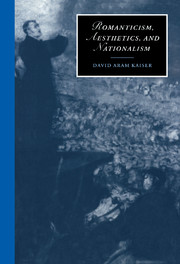Book contents
- Frontmatter
- Contents
- Acknowledgements
- List of abbreviations
- Introduction
- 1 Modernity, subjectivity, liberalism, and nationalism
- 2 The symbol and the aesthetic sphere
- 3 Schiller's aesthetic state
- 4 Symbol, state, and Clerisy: the aesthetic politics of Coleridge
- 5 The best self and the private self: Matthew Arnold on culture and the state
- 6 Aesthetic kingship and queenship: Ruskin on the state and the home
- 7 The aesthetic and political spheres in contemporary theory: Adorno and Habermas
- Notes
- Index
7 - The aesthetic and political spheres in contemporary theory: Adorno and Habermas
Published online by Cambridge University Press: 22 September 2009
- Frontmatter
- Contents
- Acknowledgements
- List of abbreviations
- Introduction
- 1 Modernity, subjectivity, liberalism, and nationalism
- 2 The symbol and the aesthetic sphere
- 3 Schiller's aesthetic state
- 4 Symbol, state, and Clerisy: the aesthetic politics of Coleridge
- 5 The best self and the private self: Matthew Arnold on culture and the state
- 6 Aesthetic kingship and queenship: Ruskin on the state and the home
- 7 The aesthetic and political spheres in contemporary theory: Adorno and Habermas
- Notes
- Index
Summary
In this final chapter, I will examine the legacy of aesthetic statism in twentieth-century theory. I began chapter 1 by citing Raymond Williams' analysis of how, during the course of the nineteenth century, an opposition developed in literary theory between subjective experience and social and political institutions. I would argue that the majority of twentieth-century aesthetic theories continue this opposition. Most twentieth-century aesthetic and literary theories continue to be based on the idea that aesthetic works constitute a special category. But, instead of connecting the special status of the aesthetic sphere to social and political formation, as was the case in aesthetic statism, most twentieth-century theory defines the special nature of aesthetic works in ways that separate the aesthetic sphere from the public sphere.
In the broadest theoretical terms, one can describe the major aesthetic theories of the twentieth century as falling towards one or the other of the two poles of objectivity and subjectivity that aesthetic statism attempted to unify. On the objective side, one can locate the various formalist approaches that focus on the interplay of formal elements within the artwork. On the subjective side, one can locate aesthetic theories which describe both the origin and effect of art in terms of private subjective experience. In general, both of these approaches minimize, ignore, or exclude the connection between the aesthetic sphere and political formation.
- Type
- Chapter
- Information
- Romanticism, Aesthetics, and Nationalism , pp. 111 - 136Publisher: Cambridge University PressPrint publication year: 1999



